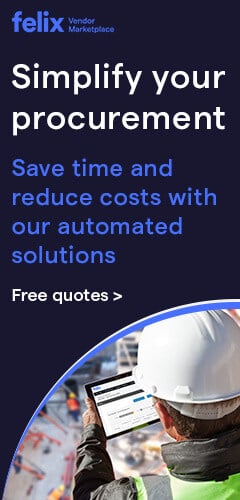Construction is a competitive industry with thousands of companies vying for work. Your competition for a construction tender ranges from small and medium-sized enterprises (SMEs) to large corporations, making winning bids critical for your own business.
Today, we will discuss how you can win more construction jobs and increase your clientele list.
But before that, what is a construction tender and what is a lead?
Also referred to as bids or proposals, construction tenders are formal invites from prospective clients to construction firms to submit an offer showcasing how you can complete a construction project.
The tender invites provide details about the project such as the scope of work, requirements and specifications, schedules, and even budget constraints that will help construction companies create their proposals.
Leads, on the other hand, are potential clients and/or projects that jump in your radar. This can be in the form of an enquiry, a referral, or any information about a construction project you encounter.
Responding to leads and in a timely manner
If you want to win more work, it is best that you respond to as many quality leads that come your way.
Each lead represents an opportunity to showcase your company, business capabilities, products and services, and track record to key decision makers. The more leads you respond to, the more opportunities you will have to get hired.
And if you need to reject or decline a request, do so in a way that will not close the doors to future opportunities to work with that possible client.
For example, you can respond like this: “Hi John. Thank you for your request for a quote for an excavator. This looks like a fantastic project but unfortunately, we cannot accommodate your project on the dates you specified. But, if you are still looking for equipment by the end of August, we’d be happy to talk more about your requirements”.
Timeliness is also as important as the response itself. We all know the excitement of receiving tonnes of requests from potential customers, but taking too long to respond to these leads could mean a loss for your business.
If you take at least five hours before responding to a lead, during that time the customer might have already found a different company to work with.
A Harvard Business Review study found that businesses that respond to leads within an hour are seven times more likely to have meaningful conversations with decision-makers. Another research also showed that 35% to 50% of sales goes to the business that responds first.
To improve response time, having a person or team dedicated to responding to leads and keeping track of them is the best option. If you are a sole trader, you can dedicate an hour or two to checking and responding to enquiries.
Other ways that you can improve response time is by creating a response template based on different types of enquiries that you frequently receive. This will help you save time and be more efficient.

Crafting your proposal or bid for a construction tender
Each construction tender has its own set of requirements that construction firms or traders need to fulfill to qualify for the job, and when you are invited to tender for a project, you are given a set of documents outlining what the client wants to see in your proposals.
Before you start making your proposal, make sure that you thoroughly understand the tender requirements. If you need more information about the tender or if something is unclear, ask the client about it and do not assume. This demonstrates that you are paying attention to detail and that you want to understand the project better.
Doing some research about the client, the project, your competitors and the market will also help you in crafting a well-made proposal that provides relevant and accurate information about your competitive pricing, schedules, cost estimates and scope of work for the project you are bidding on.
If you want to give more value to your bid and to help your company stand out, highlight your competencies, capabilities, skills or qualifications in your proposal. And if you can, include references or examples of previous projects you completed to give clients a better understanding of your capabilities.
Additionally, if you are a social enterprise, an Indigenous-owned business or employ Indigenous people, include that information in your proposal as some clients might have a social procurement quota to meet.
Lastly, make sure the documents you are submitting are well-organised, complete and free of errors. If the client is having a hard time navigating through and reading your proposal because of multiple errors and it is unorganised, it will reflect negatively on your business.
Always proof-read and double or triple check your proposals before submitting them to the client.
Build a relationship with your clients
Once you have established a solid clientele list, the next step is to nurture and build a long-lasting relationship with them.
From the first call up to the end of your contract, provide your clients with regular updates about their project or do follow-up calls to see if they need further assistance with anything regarding the project.
If a client is happy with both your work and customer service, they are willing to advocate for your business. Think referrals!
And remember that communication is a two-way street, so don’t forget to ask for feedback from your clients. Any feedback, whether good or bad, will benefit your business in the long run. It lets you know what part of your business needs to be improved, changed or maintained.
Misunderstandings and miscommunication are inevitable especially if there are multiple people involved in the project. To avoid this, establish one point of communication for both you and the client. There should only be one representative from your business with whom the client can communicate with all throughout the project and vice versa.
Embrace modern technology
Over the years, the construction sector has slowly embraced modern technology – with the use of GPS, drones, and remote access systems to name a few.
In construction, new technology isn’t just being used in equipment, it is also used to streamline processes – including in procurement, project management and even finance – and there are a number of software already out in the market specifically made for these types of processes.
Several third-party providers (such as Felix Vendor Marketplace) are also in the market to help construction firms, equipment hire companies and trades people find more leads and win more work.
Some benefits of using a third-party service provider include exposure of your business to a broader market, improved efficiency in finding leads and closing deals, and it opens opportunities to connect with key decision makers such as project managers, head contractors and engineers.
Third-party service providers or software are free to use. You can just sign up and start using the basic functions these platforms offer. However, if you want to get the full benefit from these services, then you need to pay a premium.
With premium accounts, you get to use all available features of the platform and have the option to customise according to your business needs and preferences.
You can read more about the benefits of using a third-party provider as well as some tips on choosing the best option for your business here.
Build your online presence
According to the Digital 2024 Australia report, there are 25.21 million internet users in Australia – representing about 95% of the population – and 20.80 million are social media users, which is equivalent to 86.5% of the adult population.
The report also highlights that Australians aged 16 to 64 spend an average of 6 hours and 14 minutes on the internet each day, with 1 hour and 51 minutes on social media.
This shows that the internet has truly become part of our daily lives, and if your construction company is still not on any social media platform or does not have its own website, then this is the sign to create them.
Social media
Social media platforms are the easiest to tap into, but it does take a bit of effort to gain traffic to your page.
There are several platforms that you can sign up for: Facebook, X (formerly Twitter), LinkedIn, Instagram, TikTok, YouTube – the list goes on. But you don’t have to be on every single one, you just need to sort out which platform fits your business the best.
When you start setting up your social media pages, always make sure that all information about your company is correct and up to date – especially your business name, contact details, address and operating hours.
The next step is building your social media presence. This is all about engagement and exposure. Brands that have a big social media presence are consistent in posting content on their pages and they also interact with their audience regularly. Not only will this keep your profile active, but it will also show your potential leads that you are responsive and trustworthy.
Forums, groups or communities are also available within some social media platforms, and these can be a good place to interact, share ideas and exchange information with other people working in the same industry.
Also, keep in mind that social media platforms have now become a means of communication between customers and businesses through messaging or chat functions, so always check on these as well and not miss an enquiry from a potential customer.
If you are still unsure about being on social media, here are more stats to convince you.
The Digital 2024 Australia report stated that social media is a key source of information about brands and products for about 58% of users aged 16 to 64, making these platforms a vital channel for marketers.
In Australia, Facebook is the leading social media platform with a potential ad reach of more than 16.65 million users while TikTok has the highest average time spent (per Android user) with 42 hours and 13 minutes a month.
Website
Creating a website for your construction business might not be as easy as creating a social media profile, but having one has its advantages.
Nowadays, we search the internet for pretty much anything and the internet gives us answers.
Think of your website as an online portfolio or a resume where potential customers can get to know your business better. Your website is where you can thoroughly showcase your products and services as well as your accomplishments and client testimonials, helping your business build credibility.
In addition to providing vital information about your company, your website also enables you to provide services to customers beyond your business hours.
Most businesses have their own blog pages on their website as well, and this is where they post industry-related insights, company news and updates, stories or even construction projects (like Felix Project News).
Blog posts usually cover a specific topic and could contain images, infographics, videos and/or charts. This type of content will help drive traffic to your website, boosting brand awareness that could potentially lead to conversion and revenue.
Did you find this article helpful? Subscribe to the Felix Blog today for more industry insights, news and project updates.

Related Articles

Benefits of using a third-party provider to win more work & how to find the best one
The method of cold calling and manually chasing for leads is becoming obsolete and hire companies are starting to modernise their systems. In line with this modernisation, several third-party service providers have come into the market to help vendors win more work.

Construction projects across Australia you might have missed out on this year
Following the recent standstill brought on by the global pandemic, Australia has been steadily recovering and it is evident with the vast pipeline of construction projects seen across the country.
24 of the world's most eye-wateringly over budget projects
The ultimate achievement for any construction company is to be able to report that the project came in on-time and on-budget. Learn the difference between a streamlined procurement method and the delays that can result in infamy.
Get the latest project news
- updates on Australia's pipeline of state and federal projects
- fresh contract awards from major contractors and builders
If you're looking to contact us about other matters, please contact us.



